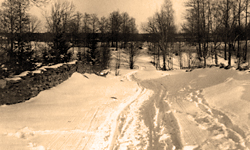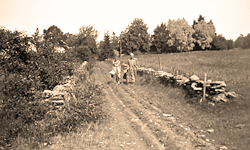Today, the village of Rootsi-Kallavere borders the city of Maardu to the West, the village of Saviranna to the North and the village of Ülgase to the East. The village was first mentioned in the Danish evaluation book (Liber Census Daniae) in 1241. At that time, Rootsi-Kallavere was located South of its current location. The village of Lillevere and a piece of empty land were then on the site of present day Rootsi-Kallavere. In 1522 the village of Rootsi-Kallavere is mentioned in the same place what was previously Lillevere. In the early 18th century the village of Kureküla emerged between the village of Rootsi-Kallavere and the manor of Ülgase. The remaining parts of those two villages – Rootsi-Kallavere and Kureküla – form present day Rootsi-Kallavere.
Until the 20th century, the church and the manor were the most influential forces in determining the development of the area. The minister of Jõelähtme church Lopenove (who was in Jõelähtme in 1863-1895) was generally well-known for promoting education. At the time of famine, he organized the construction of fences made of limestone as part of relief work. Today, the limestone fences are reconstructed with the support of EU project financing. Part of the limestone fence built on the border between the manors of Maardu and Ülgase has survived and now constitutes the border between the villages of Rootsi-Kallavere and Ülgase.

Külatee Vanapere aia ääres 70-dad.
The village has seen some hard times, but no misfortune is comparable to the devastating plague of 1710. At the end of the 17th century (1695-1697) the crops failed, which resulted in famine. About 20% of the population of Liivimaa (i.e. present day Estonia and northern Latvia) died because of the famine, that is approximately 70 000 people in total. In 1700, the Great Northern War broke out and the Russian Empire expanded as a result. In 1710 the plague broke out in Liivimaa and claimed lives from amongst those who had survived the war and the famine. In the territory of Maardu manor (which also included the village of Kallavere), 437 people, i.e. 83% of the population, lost their lives to the plague.

Tudramäe kiviaiatee
After a hundred years, i.e. in 1834 there were 179 inhabitants in total in Rootsi-Kallavere and Kureküla. In 1939, the agricultural census recorded that 79 people lived within the current boundaries of the village. According to the Population Registry, 85 people live in the village of Kallavere today. In addition, there are many who live here but for some reason are not registered. Once all the buildings, that are currently under construction or that are planned to be built, are finished, the number of inhabitants will increase considerably.
The construction of the city of Maardu started in the 1950-s. The city was established on the lands of the collective farm which in turn had previously occupied the lands of the farms of the village during the collectivisation after World War II (i.e. in the beginning of the Soviet Russia’s occupation of Estonia). Although the vicinity of the city has caused lot of grief to the village, there are positive aspects as well – the perks of the city have also been brought closer to the villagers, e.g. schools, shops, medical assistance, pharmacies and other similar services.
The names and exact locations of the villages have changed through time. However, the changes in substance are more important than changes in form. The village has always been a place for agricultural activities. During the time of manors (until the end of the 19th century) the village was inhabited by serfs, later by lessees. The squires and manor servants lived in the manors. The time of masters (from the end of the 19th century until 1949), however, was idealised because that was the time when the native pheasants owned the farms themselves as masters and were free to move around as they pleased. At that time, the villages were inhabited by masters and mistresses of the farms, the servants and craftsmen. During the time of collective farms, the inhabitants either worked for the local collective farm or went to work elsewhere. Today’s village has made another transformation: no one is engaged in agricultural activities as a source of livelihood. The village is inhabited by people who work elsewhere or are retired.
The village of Rootsi-Kallavere now lives and develops differently from how it used to be, and its future will certainly be different from its present day.
